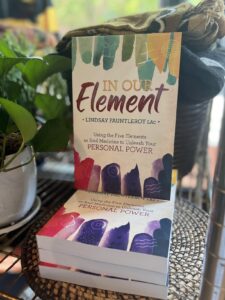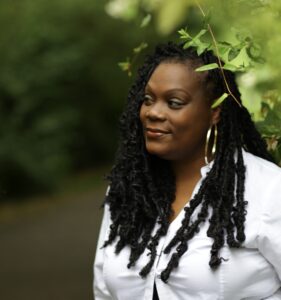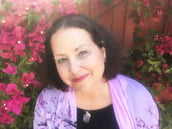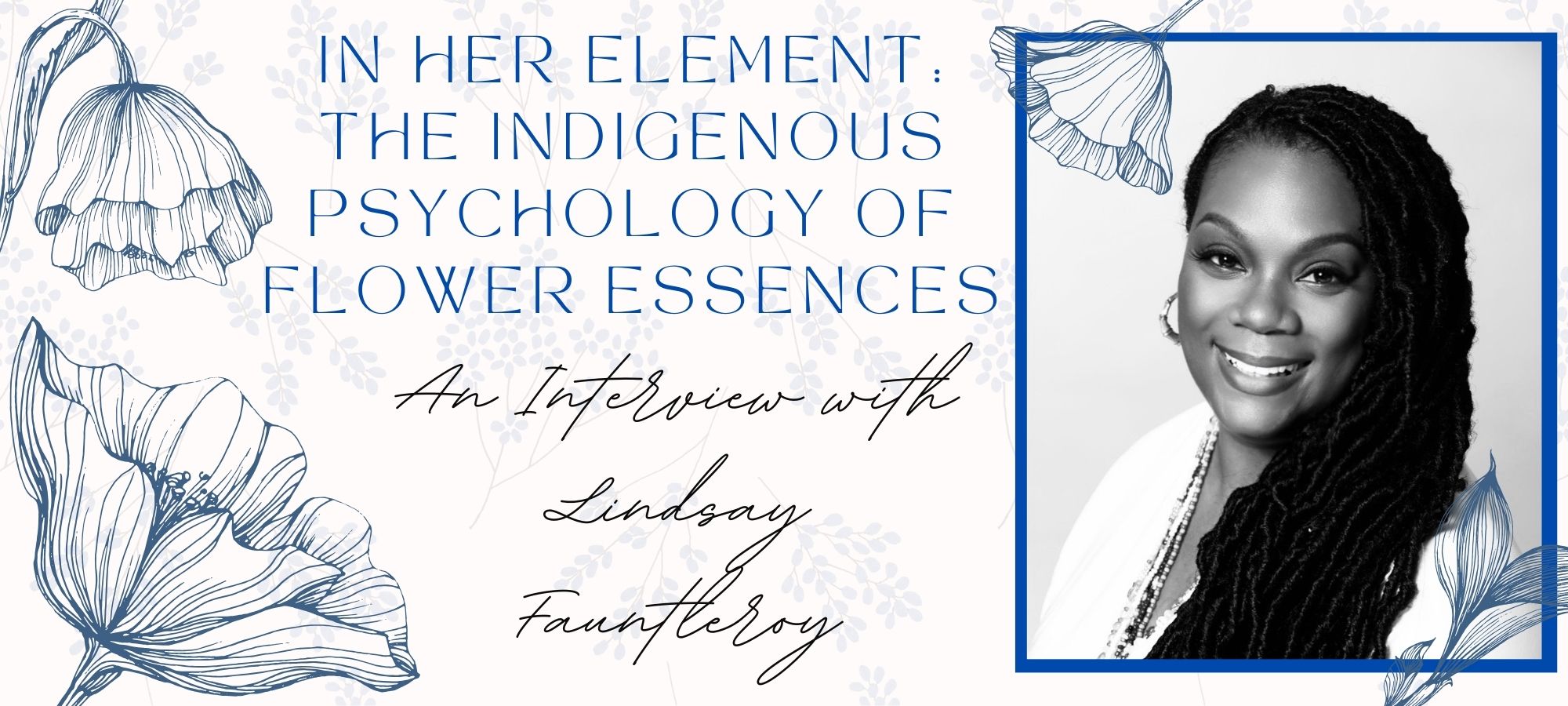An Interview with Lindsay Fauntleroy
Lindsay Fauntleroy is a second-year student of the Ph.D. in Depth Psychology with Specialization in Integrative Therapy and Healing Practices Program and currently runs TheSpiritSeed.org, creating flower essences and offering healing services. January is Mental Wellness Month, and I’m delighted to speak with Lindsay about her work and perhaps glean some tips on self-care to share with everyone.
Angela: “The Spirit Seed” is a beautiful name for a flower essence practice, and as part of it, you have The Spirit Seed Flower Essence clinic, which is facilitated by advanced student-practitioners in your certification program. For those who are not familiar, what are flower essences and how are they used in a therapeutic setting?
 Lindsay: Flower essences themselves are vibrational remedies, which are similar to homeopathic medicine. They’re taken internally and based on the philosophy that each plant has its own intelligence. It’s a good fit with depth psychology, which honors the idea that humans are not the only intelligence game in town. Each essence aligns with a particular psychological pattern, emotional block, or distortion of self-perception, and can also bring harmony, insight, and awareness. They reveal unconscious programming that creates blocks in our lives. The clinical practice of flower essences supports someone in their own archetypal discovery and integration. I approach the use of flower essence through the lens of indigenous psychology, which aligns with a depth psychological practice.
Lindsay: Flower essences themselves are vibrational remedies, which are similar to homeopathic medicine. They’re taken internally and based on the philosophy that each plant has its own intelligence. It’s a good fit with depth psychology, which honors the idea that humans are not the only intelligence game in town. Each essence aligns with a particular psychological pattern, emotional block, or distortion of self-perception, and can also bring harmony, insight, and awareness. They reveal unconscious programming that creates blocks in our lives. The clinical practice of flower essences supports someone in their own archetypal discovery and integration. I approach the use of flower essence through the lens of indigenous psychology, which aligns with a depth psychological practice.
Angela: Flower Essences are a form of plant medicine, but not to be confused with essential oils or psychedelics. The indigenous lens seems both important to you and perhaps an emerging emphasis in ecopsychology in general. Can you elaborate on the particulars of that?
Linsday: Jean Gebser is a contemporary philosopher who organized the structures of human consciousness, which he describes as Archaic, Magical, Mythical, Mental, and ultimately, Integral. I consider how reductionist, positivist approaches in science, and the Mental consciousness structure, have dominated medicine for the past few hundred years. Flower essences invite us to return to mythical and magical ways of being, where we can recognize the forces of nature as symbols, metaphors, and reflections of the human psyche. It’s a way of returning to a shared consciousness with the natural world. The essences ask us to consider what it means to be ensouled, to be in active conversation with the anima mundi. The concept of animism is prevalent in almost all indigenous cultures across the globe, even though each culture has a unique system and language to describe it. These systems are what I consider Indigenous Psychology. Flower Essence Therapy invites us away from materialism, in which we experience nature as something that’s dead and inert, respects the aliveness of nature as a teacher in a way that is practical for our contemporary content. The other blessing of the work is that I have a lot of patients who might not have any interest in ecopsychology or talking about the spirit of nature, but they still benefit from working with these essences in a practical way that facilitates a soul shift.
Angela: What is the origin of flower essences within the therapeutic context and how do they fit into the modern context of medicine?
Lindsay: Dr. Edward Bach is considered the founder of flower essences. He developed his work with flower essences in England in the 1930s in response to the soul wounds he witness as a physician treating patients after WW1 and during the Great Depression. He cultivated thirty-eight essences, and after he died, other organizations carried on with that work. There are now hundreds of flower essence remedies that have been cultivated since the late 1970s. In my private practice, I create unique formulas each month for clients, blending the various plant tinctures together to address the psychological complex or archetypal core that is manifesting through their mental, emotional, or physical symptoms. I also train wellness professionals to create flower essence prescriptions. In East Asian medicine and Five Element Theory, each element is archetypally associated with patterns of emotions, perceptions, thought distortions, and physiological experience. I created a line of flower essences based on the Five Elements and what I was seeing in my practice to make it easier for my clients and other practitioners to bring flower essences into their inner work.
There are clearly limits to human intelligence, as we see all of the turmoil in the world, largely created by our own doing. Flowers are perfect for the time we’re in, and invite us to be in connection with a larger consciousness. Depending on how a client is oriented, they may love being in conversation with another about their soul growth, having a flower essence prescription they can take when they feel stuck, or knowing that they have a flower as an ally and a soul supporter.
Angela: How did you begin your healer’s journey and how does it relate to your studies at Pacifica?
Lindsay: I’d always been interested in archetypes and myths and how myths create motivation in our lives, which was the focus of my first Master’s degree. I started my flower essence practice in 2009, as a result of my own wounded healer experience in navigating fertility. I was introduced to flower essences and acupuncture at the same time; both were transformative to me. In a time when I felt completely lost, they offered another way of thinking about psyche and soul. One of my first acupuncture teachers was also a Jungian analyst who trained us in Taoist Alchemy. After studying with her for a number of years, and being in my own practice for a decade, COVID happened. Doing acupuncture virtually wasn’t really an option, so I started thinking more systematically about how flower essences, Five Element Theory, and Afro-Indigenous spiritual traditions standing alone as a form of psychotherapy. That passion led me to Pacifica. Coming into Pacifica, I knew I was interested in depth psychology, but I really didn’t know how much it aligned with indigenous thought until after I got here. There is a bridge that connects ancestral medicine with contemporary mental health counseling, and it’s a bridge that I believe the world needs now. I feel like my time at Pacifica has widened that bridge.
Angela: You’ve said, “There is no healing of the body that does not include healing the soul and spirit. And there is no healing of the soul and spirit that does not include nature.” What role does nature play in our well-being and how can we integrate it into our daily self-care?
Lindsay: There are different gateways to connecting to nature. One way is to consume it, in terms of food and various forms of plant medicine. Practicing mindful consumption is a great way to connect, even if momentarily, to our relationship with the world outside of ourselves.
A second way is through actually being in relationship with nature: the landscape, the climate, and the forces of nature in our environment. There are indigenous spiritual systems, such as Ifá, in which the first step in spiritual development is to become a “student of nature.” These healing practices were scattered like seeds across the globe; first as the earliest civilizations migrated throughout Africa, Asia, and the Americas, and then thousands of years later as part of the African Slave Trade. These approaches invite us to consider plants, animals, climate, and landscapes as representations of archetypal forces that are constantly moving through and around us.
The flower essences offer a third doorway for relating to nature, and allowing nature to be a coach or guide as we navigate our human experience. As our lives are dynamic, there might be different ways we feel called to lean on nature. As a whole, our society tends to minimize the aliveness of the natural world, which becomes a block to receiving healing from nature.
Angela: You are the author of In Our Element: Soul Medicine to Unleash your Personal Power. Tell me about the inspiration for the book and how it relates to you.
“In Our Element weaves together Eastern medicine, Western psychology, Indigenous traditions, and African ancestral principles of spirituality. With a practical approach that incorporates journal prompts, flower essences, yoga poses, and music, Lindsay Fauntleroy teaches you how to tap into the Five Elements for a balanced and empowered life that aligns with your soul’s calling.”-LLewellyn Press
Lindsay: I started teaching Five Element courses in 2016, and I would teach this course modeled off engaging with the elements, recognizing each as an archetypal force. I was teaching and practicing, and both my clients and students who would ask for a reference text. I felt a lot of books on the Five Elements didn’t embody the elements the way I experienced them. I was living in Brooklyn, in a black body, and I wanted to show that this isn’t an ancient concept, it’s sentient wisdom that is adapting to humanity as we adapt to it. Basically, I wanted the “girlfriend’s guide” to the Five Elements, something that was an integration of the classical wisdom, academic research, and really grounded in the lived experiences of my community. The imagery was also important to me. I commissioned an artist to create illustrations of the meridians and yoga poses on figures that looked like my clients. As a melanated woman, we don’t regularly see ourselves reflected in the healing arts and wellness industry, even though we are here. I wanted to be a part of shifting that collective image of what wellness can look like, and to provide do-it-yourself tools that help to demystify the medicine.
Angela: What do you most value about your time at Pacifica? What do you most love?
Lindsay: So many things! I love my cohort, I love the relationships I’ve formed with colleagues and faculty. It’s truly like I’ve found my soul squad. I also really love how the work is working me! It’s psychically activating, its deeply resonant, it’s expansive, and a “happy place” for me to escape to. To be able to come to California once a month and immerse myself in this work feels like a huge privilege, and I’m very grateful for it.
Angela: This month is Mental Wellness Month, and I was wondering if you had any further self-care ideas to share? Simple things that anyone can do?
Lindsay: I would say a fun one is to go outside, and find something that captures your intention in the natural world, either because it’s beautiful or unusual. Notice what you notice, and spend some time reflecting on how it is a reflection of you. Draw or sketch it. Work with it as you would work with a dream. Practicing Active Imagination with the natural world can be deeply healing.
I also have to mention that flower essences are easily accessible online and in health food stores! I recommend exploring some of the essences that are out there to quiet the mind, listen to your intuition, and renew your sense of purpose.
Angela: Thank you for speaking with me today. I so admire your work and wish you the best of luck with the rest of your studies at Pacifica.

Lindsay Fauntleroy is a licensed acupuncturist who was drawn to the healing arts after her own journey to fertility introduced her to the interconnectedness of body, mind, and spirit. Her training includes a Master of Arts from New York University, a Master of Science from Tri-State College of Acupuncture, and clinical training in Traditional Chinese Medicine (TCM), Kiiko Matsumoto style Japanese acupuncture, and myofascial Trigger Point release. She is a certified instructor for the National Certification Commission for Acupuncture and Oriental Medicine (NCCAOM), as well as a facilitator of the Flower Essence Society’s global practitioner certification program.
Lindsay honors the shamanic and indigenous lineage of acupuncture, which focuses on the interconnection of body, mind, nature, and spirit. Her specialization includes stress, anxiety, depression, emotional imbalances and spiritual fulfillment. Her approach has emerged through over 15 years of clinical practice, as well as her current doctoral research in Depth Psychology and Integrative Healing Practices at Pacifica Graduate Institute. Lindsay is an advocate for reclaiming ancestral knowledge systems as tools for personal evolution and collective liberation.
Lindsay firmly believes that the power to heal should rest in the hands and hearts of all communities. She introduces acupuncture theory to contemporary audiences in her self-help book, In Our Element: Soul Medicine to Unleash your Personal Power, which is available in English, Portuguese, and Arabic. Her line of flower essence remedies, the Elementals, are available nationally and internationally. You can also find Lindsay as a featured thought-leader in Essence magazine, the SHIFT network, on numerous mind-body podcasts, and as a regular host on Sirius XM’s Urban View.

Angela Borda is a writer for Pacifica Graduate Institute, as well as the editor of the Santa Barbara Literary Journal. Her work has been published in Food & Home, Peregrine, Hurricanes & Swan Songs, Delirium Corridor, Still Arts Quarterly, Danse Macabre, and is forthcoming in The Tertiary Lodger and Running Wild Anthology of Stories, Vol. 5.


